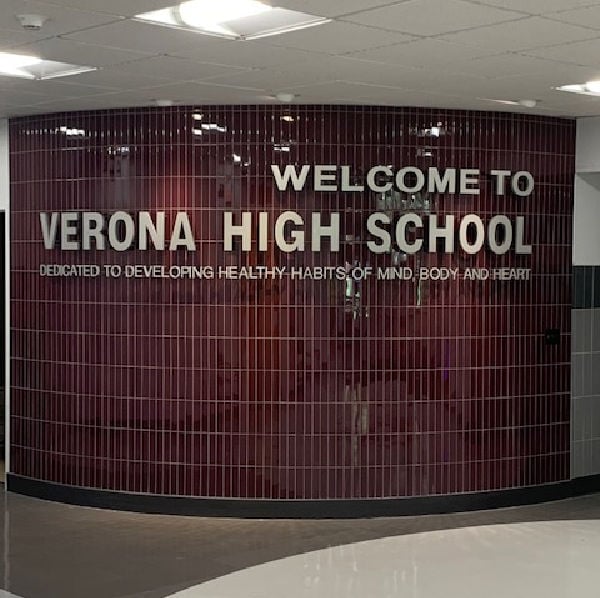
“The silence,” says Tom White. “I think the silence has been the hardest part.”
White is an English teacher at Verona High School and for much of the past 17 months, his classroom has been quieter than usual because of COVID-19. While many aspects of the global economy were completely shut down by the pandemic, children still went to school — but mostly from a computer at home. Now, after over a year of pandemic learning, teachers and administrators in the Verona public school district are reflecting on how the pandemic has affected learning, leading, and connecting with students and families.
“In the beginning, I’d say it was the immediacy that was most difficult,” says Josh Cogdill, principal of Verona High School. “A few weeks before we shut down, I asked [vice principal] Mr. Lancaster if he’d been following this coronavirus story, and he said no. We had a meeting with the staff to talk about potentially having to go remote, but many of us thought the concern was overblown. Fast-forward, though, and suddenly we’re all at home, on Google Meet, having to make [remote learning] work, and without a lot of time to prepare.”
At first, many assumed that New Jersey’s initial school closure would only be two weeks, or a month or two if the health crisis didn’t pass; perhaps at maximum, school would be closed for rest of the 2019-2020 year. However, it soon became clear last summer that a return to “normal” wouldn’t happen any time soon — and schools would have to shift from managing an acute emergency to a long-term pandemic model.
“As time went on, keeping up with guidance from the state was extremely challenging,” says Superintendent of Schools Dr. Rui Dionisio. “In June 2020, schools received the New Jersey Road Back plan [a set of New Jersey state guidance for reopening schools in the 2020-2021 school year], and each district had to submit a plan to the state. However, as guidance from the state health department changed, so did our plan for schools, because we wanted to get students back into classrooms as soon as possible.”
Yet there were differing ideas on how to get that done. “Some people wanted to be totally back to normal and be done with the pandemic,” Cogdill says. “Some people were cautious and wanted to know more before doing anything [about returning to in-person school], but still wanted to be back. And some people wanted to stay fully remote and shut down, no questions asked. “As administrators, we had to manage all three of these groups, and try and present a compromise everyone could be happy with.”
That was often hard to achieve. In October, the Verona Education Association (VEA), the teachers’ union, submitted a vote of no confidence in Dr. Dionisio over his handling of the pandemic. But only 54% of the VEA members actually voted on it and both the Board of Education and the administrative union offered unanimous support for Dr. Dionisio. (The no-confidence vote remains unresolved. While the district has had two meetings with the VEA on it, BOE President Lisa Freschi said at the June 8 meeting that the VEA’s leadership had not responded to an email requesting another meeting that had been sent in April.)
The district’s hybrid operating model, which allowed for in-person and remote learning, had to shift to fully remote several times because of rising COVID-19 cases in the schools. “It was tough to manage changes in the [school] schedule,” says White. “We cycled through quite a few schedules this year, and that made it difficult to establish a solid routine.”

Rich Wertz, mathematics and computer science teacher, concurs: “Between changes in the schedule, and the general difficulties of remote learning, I’d say we lost about 25% of our instructional time this year.” Nonetheless, these points of contention paled in comparison to a shared sense of lost connections between teachers, administrators, parents, and students, and a quiet grief for the human interaction lost during the remote-turned-hybrid year.
“Normally, I can tell when kids aren’t paying attention, who’s excited to talk about the book, who’d rather move on,” says White. “We didn’t have that this year. We taught to our computer screens in empty classrooms, and once hybrid learning started, it was tough to manage between the kids at home and the kids in person.”
“I definitely feel like I didn’t get to know my students as well this year,” says Angela Salisbury, one of VHS’ business teachers. “When we’re in person, there’s side conversations and chatter in the classroom, and I get to talk to my students. That wasn’t there this year, and I missed having a room full of kids to teach to.”
Perhaps fellow business teacher Pamela Burke sums it up best: “There’s the good chaos and the bad chaos [in the classroom], and we didn’t have either of those this year.”
Verona has been one of few New Jersey school districts to return to an almost fully reopened schedule, albeit with mask requirements in the building and an off-campus lunch period at VHS. The return to some sense of normalcy (in large part thanks to COVID-19 vaccinations) has been welcome, even if some aspects of pandemic learning are likely here to stay. “I don’t like having to teach over the computer and digitizing all my materials, but I do like Jamboards,” says chemistry teacher Dr. Janan Wehbeh of Google’s collaborative digital whiteboard technology.
“At the end of the day, I think we’ve learned a lot about the resiliency of our students and our staff,” says Dr. Dionisio. “They were presented with a huge set of challenges this year, but were able to work through them to a remarkable degree.” It’s true that Verona students have been hard at work this year, even with the challenges and restrictions presented by the pandemic; Verona athletics has had largely successful winter and spring seasons, and the creative arts — marching, concert, and jazz band, choir, and drama — have had active seasons as well. In the end, however, all acknowledge that nothing can replace the human connection and warmth created by in-person learning — and it’s this shared sense of the value of our social bonds that’s formed the largest takeaway for all involved.


